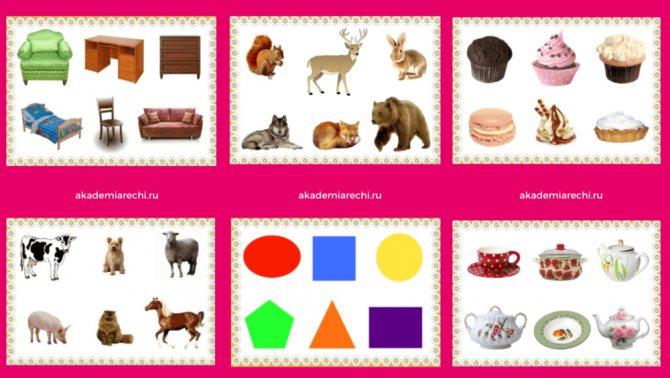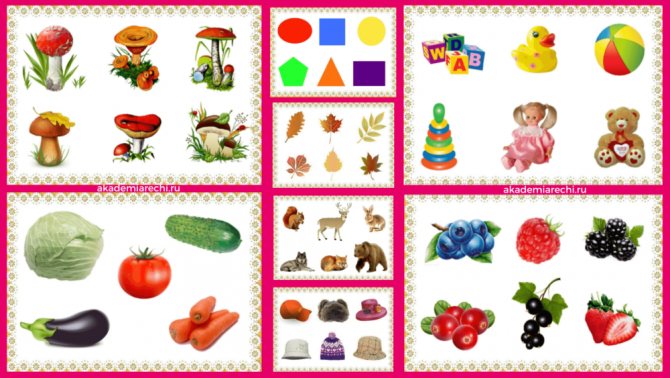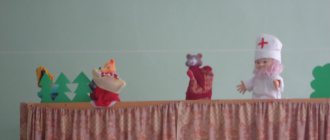The didactic game “Say it in one word” is intended for preschoolers of the older age group. It helps to consolidate terms that are generalizing for several objects on several topics: “Animal world”, “Flora world”, “Transport”, “Clothing”, “Housing” and others. Through play, a child learns to think, build logical chains, explain opinions, classify, his horizons and personal vocabulary expand.
Didactic game “Say it in one word”
You can play with one child or a group of children. The educational activity is suitable for preschoolers 5 years old and older; it can also be used in the first grade of school.
The goal of the didactic game “Name it in one word” is to consolidate the skill of classifying objects.
Tasks:
- developing the skill of classifying objects in the surrounding world;
- expansion of an individual dictionary on several topics at once;
- learning the ability to think, explain, unite;
- broadening one's horizons, developing curiosity and interest in the game form of learning;
- improvement of visual and auditory perception, memory, speech skills;
- developing the ability to concentrate, think logically, and think;
- fostering perseverance, correct behavior, and the ability to work productively in a team.

“Features of developing hard work in older preschoolers”
Ministry of Education and Science of the Russian FederationFederal State Budgetary Educational Institution of Higher Education"Chechen State Pedagogical University"Faculty of Correspondence StudiesDepartment of Pedagogy and Preschool Psychology"To Defense"
Head department PiDP
_________Z.I.Gadaborsheva
"___" ____________2018 GRADUATE QUALIFYING WORK
(qualification – bachelor)
Topic: “Features of developing hard work in older preschoolers” Completed by: student
Directions 03/44/01 –
Teacher Education,
profile - "Preschool education".
| ____________ | Umkhazhieva M. | |
| Supervisor | ____________ | Gebekova A.N. |
| Consultants: | ||
| 1.Analytical part | ____________ | Gadaborsheva Z.I. |
| 2. Practical part | ____________ | Gebekova A.N. |
| Norm controller, hands. UMU | ____________ | Khataeva R.S. |
| The project is protected for evaluation _______________________________ | ||
| Protocol No.________ “_____”________________ 2017 | ||
| Secretary of the State Attestation Commission | ____________ | Mavlokhadzhieva A.A. |
Grozny, 2018
Contents Introduction________________________________________________________________3 Chapter 1. Theoretical foundations of the problem of developing hard work in older preschoolers_________________________________________________7 1.1. General characteristics of a preschooler’s work activity ________7 1.2. Social and pedagogical prerequisites for the need to instill hard work in preschool children___________________________14
1.3 Content of labor education in kindergarten MBDOU No. 125 “Smile”__________________________________________________________18
Conclusions on Chapter I_____________________________________________26 Chapter 2. Experimental work on developing hard work in older preschoolers using the example of MBDOU No. 125 “Smile”___________28 2.1. Characteristics of the system of pedagogical activities for the formation of hard work in older preschoolers in MBDOU No. 125 “Smile” ________________________________________________________________28 2.2. Comparative analysis of the results of experimental work on the formation of hard work in older preschool children in MBDOU No. 125 “Smile”______________________________________________________________40 Conclusions on Chapter 2_____________________________________________46 Conclusion_______________________________________________________________48 References___________________________________________51 Appendix ________________________________________________54 Introduction
Analyzing preschool age as the basic stage of development of personal qualities, the concept of lifelong education defines the essence of a new approach to preschool education in connection with the implementation of federal state educational standards of preschool education, based on the principles of variable content, pedagogy of development, and a preschooler’s knowledge of the world through the types of activities that interest him and organize him. A mechanism has been developed that subordinates the quality of preschool education to the state standard - criteria for assessing the activities of preschool institutions; conceptual foundations of preschool education. At the same time, the concept draws attention to the development of personal qualities necessary for the further development of the individual: curiosity, initiative, communication, creative imagination, arbitrariness.
Despite all this, the concept does not include the task of instilling hard work. Meanwhile, a number of indicators of hard work (awareness of the goal of activity and perseverance in achieving it; readiness to complete the work begun; manifestation of an emotionally positive attitude towards work; positive assessment of the results of activity; accuracy, diligence, careful attitude to the means and products of labor) are most successfully formed in preschool and primary school age in the works of such teachers as R.S. Bure, G.N. Godina, M.V. Krulekht, V.I. Loginova, T.A. Markova, V.G. Nechaeva, D.V. Sergeeva and others.
The lack of development of these qualities at this age stage becomes an obstacle to educational and cognitive activity during training at the primary level and subsequent adaptation to independent work. The importance of labor as a factor in the development of a child’s personality is reflected in the works of such domestic teachers as: P.P. Blonsky, N.K. Krupskaya, A.S. Makarenko, V.A. Sukhomlinsky, S.T. Shatsky and others. Theoretical confirmation of the labor education of youth with access to practical recommendations is highlighted in the works of teachers P.R. Atutova, A.A. Akhmatova, S.Ya. Batysheva, K.N. Katkhanova, V.A. Polyakova and others.
The development of a positive attitude towards work in preschool children is influenced by its content, forms, methods of managing work activity and the conditions of its organization, as well as the collective nature of the activity, the formation in children of concepts about adult work, social motives for work, the availability of skills, and the creation of a working atmosphere. The issue of the role of the emotional state of the child in the process of labor activity, a differentiated approach to children in determining methods of influencing the organization, and the formation of labor education on them is considered. The participation of these factors has not been sufficiently studied: the methods and techniques of pedagogical influences do not take into account the changes that occur in the child’s attitude to work, work activity in the process of labor education and work activity; The question of how work has a positive impact on the emotional state of the child and contributes to his further activities has not been sufficiently studied. The pedagogical literature notes that the formation of a child’s attitude towards work is influenced by the level of physical activity, the regularity of children’s participation in work, and the involvement of children in self-care. Thus, despite the variety of works exploring the problem of labor education, the issues of comprehensive substantiation of pedagogical conditions for creating a positive attitude towards work have not been sufficiently resolved. The systematic inclusion of each child in work, the correct work schedule, the creation and maintenance of a positive emotional state of the child at all stages of work can cause children to have a constant desire to work. And a gradual change in types of activities will ensure on this basis the formation of a positive attitude towards work and work activity.
Thus, the relevance of the study determined the topic of our final qualifying work “Features of the formation of hard work in older preschoolers”
0.81 Mb.
Share with your friends:
Game options
The simplest version of the lesson is for the teacher to show a card, and the student names the illustrated object. For example: “Who is drawn here?” - “Crow”, “Swallow”, “Tit”, “Crane”, “Bullfinch”, “Cuckoo” - “Name what you drew in one word?” - "Birds". Or: “What is drawn here?” - “Boletus”, “Chanterelles”, “Honey mushrooms”, “Boletus”, “Volnushka”, “Green milk” - “And together is this?” - "Mushrooms".

For the didactic game “Name 1 word”, you can make cards in the following categories:
- pets;
- forest animals;
- birds of our region;
- insects;
- river fish;
- Marine life;
- fruits;
- flowers;
- edible mushrooms;
- vegetables;
- berries;
- trees;
- transport;
- Kids toys;
- cookware;
- furniture;
- food products;
- sports accessories;
- school supplies;
- wardrobe;
- musical instruments;
- household tools.

You can organize a team game. Have the students divide into two groups. The teacher shows cards to groups of players in random order. Children must list the objects and give them a common name. The team with the most correct answers wins.
When playing with cards, you can combine objects not only by general properties, but also by color, edibility or inedibility, living or inanimate state.
You can also make a fun puzzle game. For it, you need to cut out pictures of such a shape that images of the same category are combined into a single canvas. The players' task is to correctly put together puzzles, name the objects depicted and the concept that unites them.
"Find dangerous objects"
The game forms and reinforces ideas about everyday objects that pose a danger to health and life. Kindergarten students learn to identify dangerous things and use them correctly.
The game expands vocabulary, develops speech skills and logical thinking, and teaches the basics of proper behavior at home.
For the lesson, you need to cut out a large flower from paper, on each of the petals of which there is a picture of a dangerous domestic incident (cut, poisoned, burned by flame, etc.). You also need to prepare paper circles depicting things that correspond to dangerous cases (knife, chemical, gas stove on, etc.).
The teacher lays out the mugs, asks the students to place them correctly on the petals, explain the choice, and tell why the chosen item is dangerous.
"Find identical objects"
For an activity that develops concentration, you need cards depicting several objects, including two or more identical ones. The child’s task is to find identical ones.



